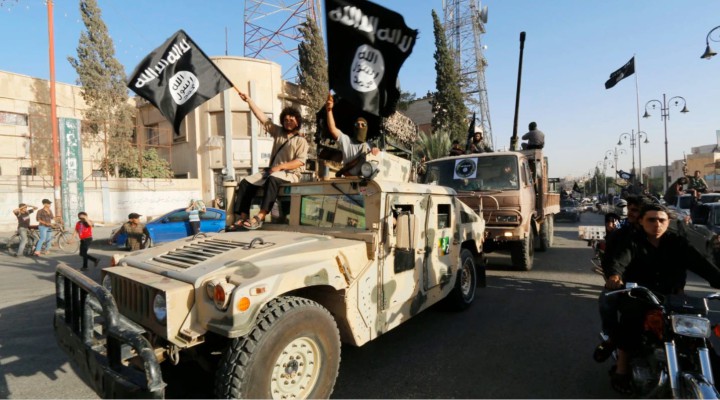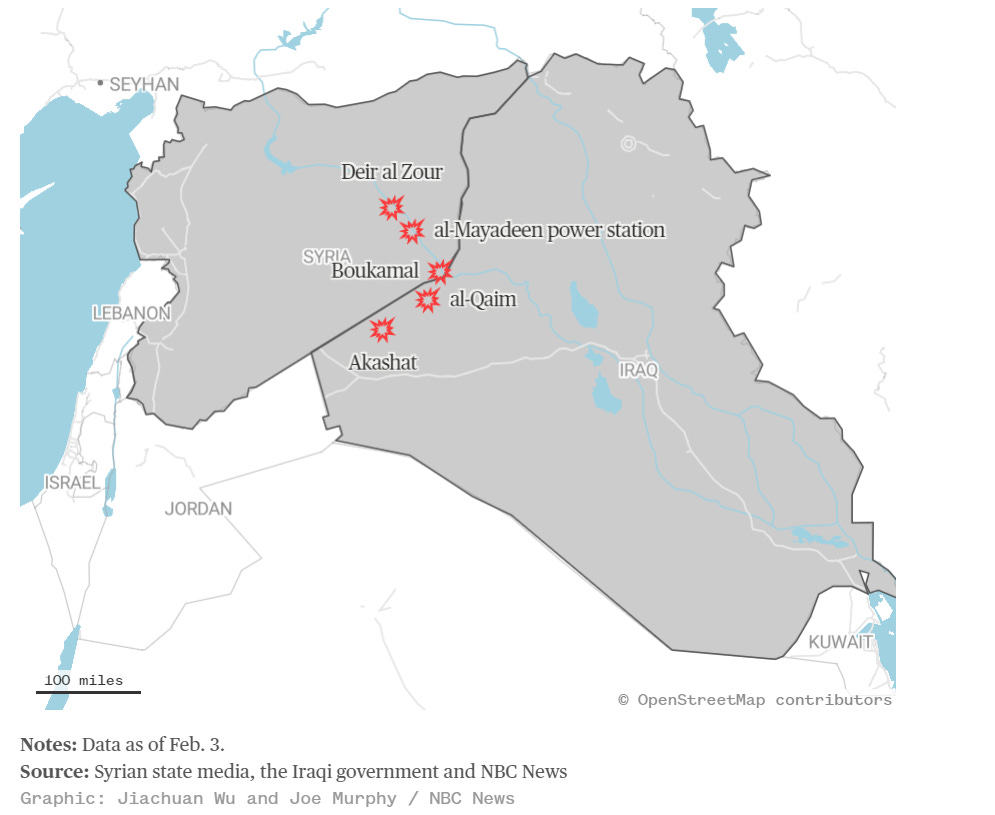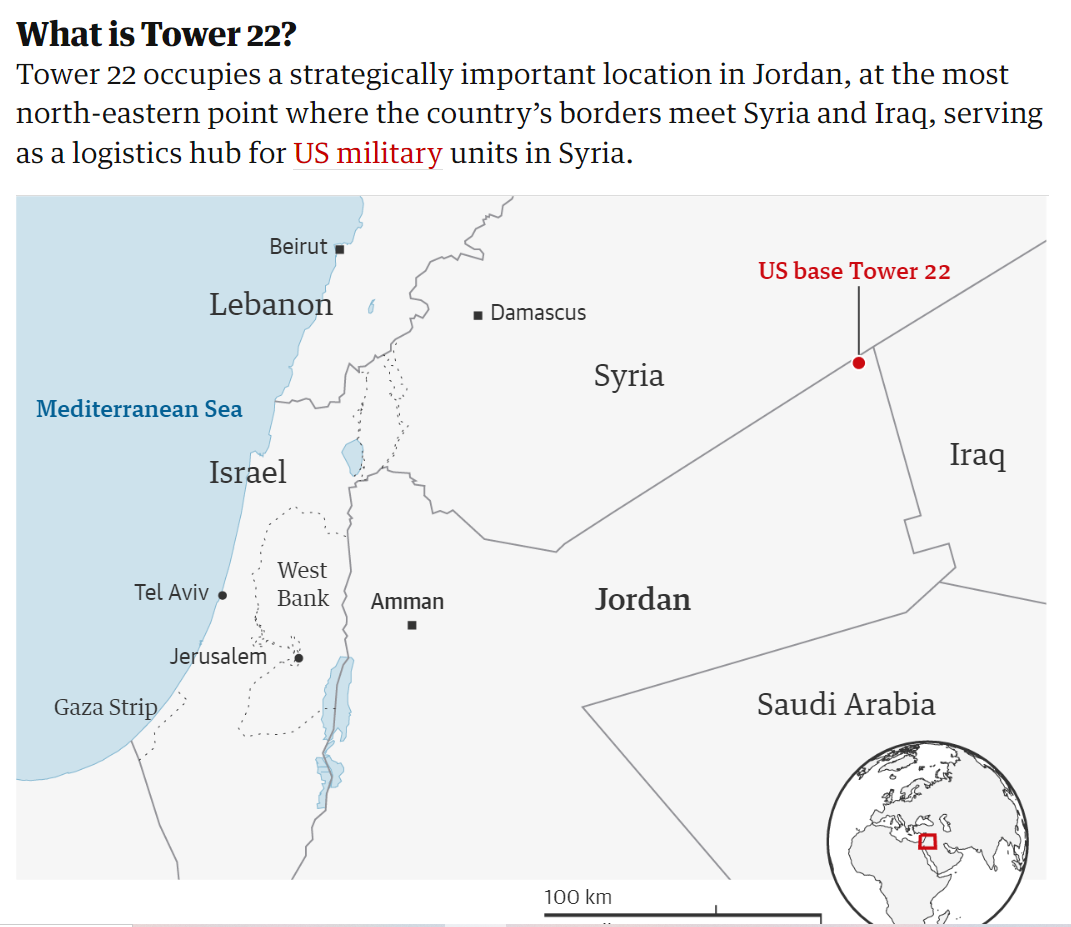U.S. attacks on Syria and Iraq – ‘deterrence’ or escalating conflict in the region?

The U.S. is losing face but just can’t stop its war policy
Tonight I will have a very important conversation with University of Tehran professor Seyed Mohammad Marandi to bring some clarity to the recent U.S. aggression against Syria and Iraq.
In preparation, here is a summary of recent events in Syria and Iraq.
The Syrian Ministry of Defence issued the following statement (translated from Arabic) on the U.S. attacks carried out at dawn on the 3rd February:
Today at dawn, the American occupation forces launched a blatant air attack on a number of sites and towns in the eastern region of Syria, near the Syrian-Iraqi border, which led to the death of a number of civilians and soldiers, the injury of others, and the infliction of significant damage to public and private property.
The area targeted by the American attacks in eastern Syria is the same area where the Syrian Arab Army is fighting the remnants of the terrorist organization ISIS. This confirms that the United States and its military forces are involved and allied with this organization, and are working to revive it as a field arm for it, both in Syria and Iraq, by all dirty means.
The aggression of the American occupation forces at dawn today has no justification other than an attempt to weaken the ability of the Syrian Arab Army and its allies in the field of fighting terrorism, but the army that was able to defeat various terrorist organizations over the past years will continue with its steadfastness and its principle of defending Syria’s land and people and striking all organizations no matter how hard they try. Its sponsors and supporters hinder this goal.
The occupation of parts of Syrian territory by American forces cannot continue, and the General Command of the Army and Armed Forces affirms its continuation of its war against terrorism until its elimination and its determination to liberate the entire Syrian territory from all terrorism and occupation.
While the U.S. claimed it was targeting Iranian Revolutionary Guard (IRGC) positions, the reality is that the casualties were civilians, Syrian Arab Army (SAA) forces and PMU (Iraqi Resistance factions). In other words, the targets were the enemies of U.S. proxy terrorist group, ISIS in Iraq and Syria.
The following is a statement from a member of the Iraqi Parliament, Mustafa Sanad:
“Whenever news from the White House claims that US airstrikes are directed against Iranian-backed armed factions that targeted US bases in the region, and that these airstrikes are effective, be sure they are fake news.
All of the strikes are aimed at Iraqi national forces associated with the Popular Mobilization Forces (PMU/Hashd al Shaabi), an official government entity.
These strikes have no negative impact on the resistance factions, but rather on the Iraqi people, who hold the Popular Mobilization Forces in high regard. Drone attacks against US bases continue, and US airstrikes are ineffective at deterring
them.”
According to my sources, 25 were killed in Syria, 17 in Iraq but this number may well rise as many others were critically injured in the attacks – civilians, PMU and SAA.
The U.S. launched strikes against more than 85 targets. The long-range B1 Bombers flew from bases inside Kuwait, Jordan and Qatar.
“U.S. military forces struck more than 85 targets, with numerous aircraft to include long-range bombers flown from the United States,” CENTCOM said in a statement. “The airstrikes employed more than 125 precision munitions.”
Iraq summoned the U.S. charge d’affaires in Baghdad to deliver a formal protest.
“Iraq reiterated its refusal that its lands be an arena for settling scores or showing force between warring countries,” the Iraqi foreign ministry said in a statement.
White House claims that Iraq was informed in advance of the aggression were denied and proclaimed false by Iraqi government officials. Bassem Al Awadi, Iraqi government spokesperson said that the U.S.:
“deliberately deceived and falsified the facts, by announcing prior coordination to commit this aggression, which is a false claim aimed at misleading international public opinion and disavowing legal responsibility for this rejected crime in accordance with all international laws.”
“..all parties” must realize that Iraq refuses to let its lands become “an arena for settling scores,” and that the nation’s sovereignty and land are not the place to “send messages” between opponents or demonstrate force.
“This aggressive strike will put security in Iraq and the region on the brink of the abyss, and it also contradicts efforts to establish the required stability,”
White House national security spokesperson John Kirby said the strikes were meant to reduce capabilities, as well as send a message to Iran and groups it supports to halt attacking Americans while still reciting the mantra that “We’re [U.S.] not looking for a war with Iran.”
Iraq has threatened to cease oil supply to Jordan because of the country’s involvement in the attack as a launch pad for the U.S. B1 bombers.

Map of the U.S. targets according to NBC.
A ‘coincidental’ ISIS resurgence
ISIS exploited the U.S. attacks to carry out intense attacks against the Syrian Arab Army and PMU positions on the 160th km area of what is known as the Al Sakkar highway:
The Iraqi Al-Nujaba satellite channel said that ISIS took advantage of the US bombing of targets in Iraq and Syria by launching an attack on the army and the PMU forces in the area of Kilometer 160 on the Al-Sakkar highway near the town of Rutba in Anbar.
According to local sources, the attacks are still ongoing but are being repelled.
Gulf-backed Syria researcher Charles Lister wrote in Foreign Policy on 24 January that ISIS is enjoying a resurgence and that 10,000 ISIS militants are detained within at least 20 makeshift prisons in US and Kurdish-controlled northeastern Syria, constituting an ISIS “army in waiting” and its “next generation.”
On January 16th, The Cradle reported on the regional revival of ISIS, particularly in the Houran area of Iraq. The prediction of renewed ISIS hostility backed by the U.S. alliance appears to have come true:
“Noticeable activity by the organization had been recorded a few weeks ago in the west of the country. Near the Rutba desert, ISIS fighters were spotted digging underground hideouts. Information indicates that the organization is in the process of carrying out terrorist operations in many locations,”
Al Qaim and Akashat were also areas formerly under the control of ISIS until liberation in 2017.

From The Guardian
Tower 22 narrative
The Tower 22 story that claims the Islamic Resistance Iraq targeted a remote U.S. outpost in north-east Jordan has been denied as false by sources inside Syria. They have told me that the drone missile targeted an area between the illegal U.S. military base of Al Tanf and Rukban “refugee” camp which is known locally to be a recruitment hub for terrorist groups including ISIS.
Al Tanf is also host to various extremist groups and is a training center for ISIS and other organisations – many of the recent attacks on SAA positions in the central Syrian Badia (desert) area have been launched from Al Tanf on the border with Jordan.
It is also bizarre that the media whipped up a frenzy over the alleged killing of 3 American military personnel and the injuring of up to 47 others when there have been 160 prior attacks on illegal U.S. bases in Syria and Iraq that have also included fatalities and injuries.
The claim the attack was inside Jordanian territory is clearly to avoid the U.S. having to admit it has 22 illegal military bases inside Syria of which Al Tanf is the largest and the primary terrorist holding/training centre.
Iran’s Ambassador to Damascus Hossein Akbari denied that any Iran-linked targets were hit and reiterated claims that the aim was to destroy Syria’s civil infrastructure.
“The terrorist act of the American government during the aggression last night was carried out most of all with the aim of compensating for the failures of the Israeli regime in the Gaza Strip and creating a vacuum on the borders of Iraq and Syria in order to strengthen the armed takfiri terrorists. Contrary to claims of attacks on Iranian bases and advisers, yesterday’s attacks were aimed at destroying Syrian civilian infrastructure.”
From the videos circulating of the attacks, it is clear also that Resistance ammunition and equipment storage was targeted and hit during the aggression to degrade their capability to combat U.S.-backed ISIS terrorists in the area of the north-east and eastern borders with Iraq.
The U.S. has as its agenda, the control of the entire eastern Syrian border including Al Bukamal crossing to totally impede the road connection from Iran, through Iraq to Syria and to Palestine or Lebanon.
Deir Ezzor was reported to be without electricity after Al Mayadeen power station was struck.
The Syrian Foreign Ministry condemned Washington’s blatant aggression and “rejects all justifications and lies marketed by the U.S. administration. The U.S. aggression on Syrian territories is a “strong proof that it is the main source of global instability and its military forces threaten international peace and security”
Immediately after the aggression it has been reported by local sources in the north-east that the U.S. has resumed the theft of Syrian oil and its transportation to U.S. bases in Iraq.
Civil sources from Yaroubiya countryside near the Iraqi border told SANA reporter that a convoy, consisting of 60 tanker trucks loaded with stolen Syrian oil left Syrian territory towards the occupation bases in northern Iraq via the illegitimate Mahmoudiyah crossing.
The convoy was accompanied by an escort from the occupation forces and the separatist militia of QSD, the sources added.
The U.S. attacks have not been a successful deterrence against the Islamic Resistance Iraq (IRI) operations in Iraq and Syria. On the contrary, they have hardened the resolve of the Resistance coalition. While Kata’ib Hezbollah had issued a statement that it would cease attacks on U.S. bases so as to avoid embarrassment for the Iraqi government – it has continued attacks on Israeli targets in support of Palestine, particularly in Eilat.
IRI have resumed attacks against U.S. bases since the 3rd February – including three attacks on Koniko oil field north of Deir Ezzor. In a statement released in early Saturday, the resistance said it had conducted missile strikes against the Ain al-Assad Airbase housing US occupation forces in the western Iraqi al-Anbar Province as well as Harir in Erbil.
The group also said it had staged missile and drone strikes against the strategic al-Tanf military base in southeastern Syria near the border with Jordan and Iraq as well as the al-Khadra Village in Syria’s northeastern province of al-Hasakah. (Press TV)
Today 5th February, the EU-funded Syrian Observatory for Human Rights (SOHR) reported on the death of seven Kurdish separatist ‘commandos’ and the injury of 18 others in an attack on the Al Omar oil field U.S. illegal base in the eastern countryside of Deir Ezzor.
The PMU and other Resistance factions are integrated into the official Iraqi military – this therefore creates another serious dilemma for the Pentagon that would prefer to portray them as rogue “Iranian proxies” – a claim that is dishonest and deliberately misleading for the American public.
International condemnation
Dmitry Polyanskiy, First Deputy Representative for Russia at the United Nations went on X:
Russia has just called for an urgent UN Security Council meeting to discuss threats to international peace and security from the US strikes against Iraq and Syria. The meeting is expected to be held at 4 pm EST on February 5
Foreign Ministry Spokeswoman Maria Zakharova said on Saturday that US airstrikes on the two countries in West Asia once again demonstrated the aggressive nature of Washington’s foreign policy.
“It is obvious that the airstrikes are deliberately designed to further inflame the conflict.”
Washington, she said, “is purposefully trying to drive the largest countries in the region into conflict.”
“Recent events confirm that the United States is not and has never been looking for solutions to problems in the region.”
Cuba has condemned US aggression in Syria and Iraq as “violations of the sovereignty and territorial integrity” of the two countries and of international law.
“Cuba strongly condemns the US aggression against Syria and Iraq, which is a blatant violation of the sovereignty of these countries. These irresponsible actions violate international law, increase the escalation of violence and contribute to the possibility of regional conflict,” Cuban Foreign Minister Bruno Rodríguez Parrilla said in his account on the X platform.
As a result of the U.S. attacks there are renewed calls in Iraq for the expulsion of American forces from the country.
A reminder that the IRI had previously also threatened Zionist shipping in the East Mediterranean, a threat that is yet to be carried out and will most likely include missiles or drones launched from inside Syrian territory.
The Israel factor
Despite the belligerent rhetoric from Zionist War Minister, Yoav Gallant and others, the threatened escalation and invasion of Lebanon is still not taking place.
The Zionist attempts to force Washington’s hand to push Hezbollah north of the Litani River have failed and Israel now has no alternative but to consider negotiations with Hezbollah with the U.S. as intermediary. Israel’s ground invasion in Gaza has been an abject failure with IOF casualties far higher than the Zionist regime is admitting publicly.
Israel’s borders are now insecure and internally the colonialist settler project is in turmoil. It can be interpreted that the U.S. carried out these attacks to distract from the disintegration of their military garrison in the region.
Apologies for the rather lengthy ‘summary’.
I will discuss all these developments and the regional repercussions in my conversation with Mohammad Marandi tonight, to be published tomorrow.
https://beeley.substack.com/p/us-attacks-on-syria-and-iraq-deterrence
Here is the interview:
The U.S. failed ‘shock and awe’ aggression in Iraq and Syria – with Seyed Mohammad Marandi
 TheAltWorld
TheAltWorld 
One thought on “U.S. attacks on Syria and Iraq – ‘deterrence’ or escalating conflict in the region?”